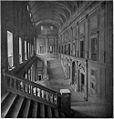Alcázar of Toledo


The Alcázar of Toledo (Spanish: Alcázar de Toledo, IPA: [alˈkaθaɾ ðe toˈleðo]) is a stone fortification located in the highest part of Toledo, Spain. It is a large quadrangular building measuring 60 meters on a side, framed by four large towers 60 meters high, each crowned by the typical Madrid spire. Most of the building was rebuilt between 1939 and 1957 after the siege of the Alcázar during the Spanish Civil War.[1]
History[edit]
Once used as a Roman palace in the 3rd century, it was restored under Charles I (Charles V, Holy Roman Emperor) and his son Philip II of Spain in the 1540s.[2] In 1521, Hernán Cortés was received by Charles I at the Alcázar, following Cortes' conquest of the Aztecs.[3] The name is from Arabic al-qaṣr 'the castle' (ultimately, from Latin 'castrum').
Spanish Civil War[edit]

During the Spanish Civil War, Colonel José Moscardó Ituarte held the building against overwhelming Spanish Republican forces in the siege of the Alcázar. The incident became a central piece of Spanish Nationalist lore, especially the story of Moscardó's son Luis. The Republicans took 24-year-old Luis hostage, and demanded that the Alcázar be surrendered or they would kill him. After briefly speaking to his son on the phone to confirm this, Moscardó told Luis to, "Commend your soul to God, shout 'Viva España!' and die like a hero''.[4][5]
Moscardó refused to surrender. Contemporary reports indicated that the Republicans then killed Moscardó's son. Other historians have reported that Luis was not in fact shot until a month later "in reprisal for an air raid".[6] The dramatic story also camouflages the fact that the fate of a number of male hostages, mainly from the Guardia Civil, taken into the Alcázar at the beginning of the siege is unclear. Some sources say the men "were never heard of again".[7] However at least one journalist who visited the Alcázar in the immediate aftermath of the siege saw a number of prisoners chained to a railing in a cellar.[8]
The events of the Spanish Civil War at the Alcázar made the structure a symbol for Spanish Nationalism and inspired the naming of El Alcázar, a far-right newspaper that began during the civil war and ended during the Spanish transition to democracy as the mouthpiece for Búnker, a faction of Francoists who opposed reform after Francisco Franco's death.
By the end of the siege, the building had been severely damaged. After the war, it was rebuilt. It now houses the Castilla-La Mancha Regional Library Archived 2009-06-02 at the Wayback Machine ("Biblioteca Autonómica") and the Museum of the Army ("Museo del Ejército"), the latter having previously been housed in the Salón de Reinos in Madrid.
-
Heinrich Himmler visits the Alcázar with José Moscardó in October 1940
-
Two women and a man at the siege of the Alcázar in Toledo, 1936
-
Interior of the Alcázar in 1901, Jean Laurent
-
Toledo in 1887
-
"Interview of Emperor Charles V with Francisco Pizarro in the Alcázar", ca. 1887 by Ángel Lizcano Monedero
-
Inner courtyard
-
Tent of Charles V, Army Museum
References[edit]
- ^ VALLE SÁNCHEZ (December 16, 2013), La reconstrucción de Toledo tras la guerra civil, paso a paso, ABC
- ^ Henry Kamen, Philip of Spain, (Yale University Press, 1999), 184-185.
- ^ Toledo and the New World in the Sixteenth Century, Javier Malagón-Barceló, The Americas, Vol. 20, No. 2 (October 1963), 124.
- ^ https://wesscholar.wesleyan.edu/etd_hon_theses/38/ Cartwright-Punnett, Lynn, 2008 Wesleyan University p.20
- ^ Reig Tapia, Alberto. "Memoria de La Guerra Civil: Los Mitos de La Tribu". p. 173. Retrieved 2018-02-22.
- ^ Thomas, p 311
- ^ Beevor, p122
- ^ Eby, p187
Sources[edit]
- Cecil Eby, The Siege Of The Alcázar, 1965
- Hugh Thomas, The Spanish Civil War, 4th Rev. Ed. 2001.
- Antony Beevor, The Battle for Spain, 2006.









